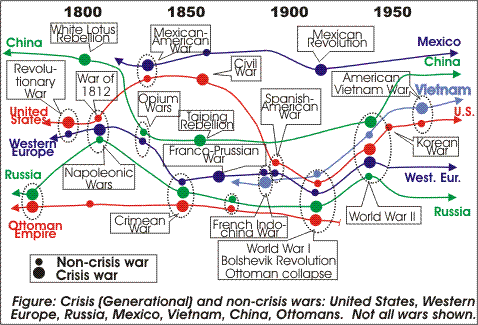No they are not. What I wrote was my conception of how your model works.Originally Posted by John J. Xenakis
Do you have a revised mechanism?So a threshold defined by the number of veterans (or Artists) remaining from the previous war is not something that I would agree would be the sole basis for crisis wars.
I just used Ockham's razor here. In the absence of a specific reason to believe that the incidence of wars (all types) follows a pattern, I assume they do not.As for whether wars occur at "random" times, I can't really say.
How so, don't they share the commonality of being wars?I'm also generally nervous about relating non-crisis and crisis wars to each other in any significant way, since they're so different.
So you have completely abandoned the idea that another crisis war cannot follow closely after another because too many are left who remember the first one?The extent to which the two can be exchanged based on a
"threshold" of some kind is far from clear. I consider crisis wars
and non-crisis wars to be so different from one another that little
meaningful comparison can be made.
This replenishment mechanism would call for at most a 25 year spacing (time to raise another batch of soldiers--see WW I to WW II spacing). Besides didn't you already note that mass casualties are NOT an determinant of crisis wars. After all WW I wiped out a generation of Frenchman yet was not a crisis war for the French, while the Franco Prussian War and WW II had comparatively few French casualties, yet were crisis wars for the French.My idea was that a genocidal crisis war kills enough people and uses up enough resources that it takes several decades to replenish the society's resources to the point where another crisis war is possible. The "point of minimum replenishment" appears to be 45-50 years after the end of the previous crisis war.
This is a serious issue with GD. Why a war is a crisis war or a non-crisis war is pretty central to GD, or at least it used to be.That's the question I would ask of you, and of anyone else who cares to answer: What was different in the American public in the 1950s
from the 1940s, and how do I characterize it in the GD model?
Is explanation of data like this the purpose of a theory? I cannot explain it because I don't follow the GD paradigm, largely because I cannot reconcile my understanding of it (which you now point out is incorrect) with these spacing.In fact, what I really want is an explanation of this table, which
I've posted many times before:
Why is it that a new crisis war NEVER occurs less than 41 years afterCode:LENGTH OF INTER-CRISIS PERIOD Fraction # years of total ------- -------- 0- 40 0% 41- 49 11% 50- 59 33% 60- 69 25% 70- 79 16% 80- 89 4% 90- 99 6% 100-117 5%
the end of the previous one, and RARELY occurs less than 50 years
after?
The spacing of crisis wars determines the "saeculum" length according to GD. With the S&H saeculum one obtains the analogous lengths from the spacing of like turnings. Using the S&H dates back to 1435 and the McGuiness ones back to 1147 a distribution of lengths can be obtained like what you show here:
64-74y 9%
75-84y 13%
84-99y 28%
100-11 50%
The distribution is actually bimodal, with one cluster centered at 72 years with a 7-year SD and another clustered at 102 years, also with a 7-year SD.
I could never reconcile the S&H mechanism with this set of lengths, which is why I have always maintained that the S&H model or mechanism is incorrect, even though I believe the saeculum exists. Recently I have begun a determined effort to come up with a mechanism that works, fits the lengths and for which I can identify supporting evidence.
The first order of business was to understand exactly how the S&H mechanism works. I found I didn't really understand it in the past (S&H didn't make it very clear).
- Join Date
- Jul 2001
- Location
- Kalamazoo MI
- Posts
- 4,501
